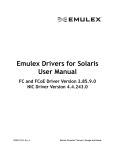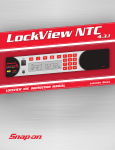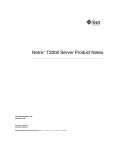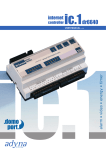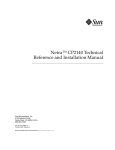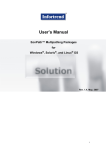Download Netra SPARC T4-1B Server Module
Transcript
Netra SPARC T4-1B Server Module Product Notes Part No.: E25044-04 February 2013 Copyright © 2011, 2013, Oracle and/or its affiliates. All rights reserved. This software and related documentation are provided under a license agreement containing restrictions on use and disclosure and are protected by intellectual property laws. Except as expressly permitted in your license agreement or allowed by law, you may not use, copy, reproduce, translate, broadcast, modify, license, transmit, distribute, exhibit, perform, publish, or display any part, in any form, or by any means. Reverse engineering, disassembly, or decompilation of this software, unless required by law for interoperability, is prohibited. The information contained herein is subject to change without notice and is not warranted to be error-free. If you find any errors, please report them to us in writing. If this is software or related software documentation that is delivered to the U.S. Government or anyone licensing it on behalf of the U.S. Government, the following notice is applicable: U.S. GOVERNMENT RIGHTS Programs, software, databases, and related documentation and technical data delivered to U.S. Government customers are "commercial computer software" or "commercial technical data" pursuant to the applicable Federal Acquisition Regulation and agency-specific supplemental regulations. As such, the use, duplication, disclosure, modification, and adaptation shall be subject to the restrictions and license terms set forth in the applicable Government contract, and, to the extent applicable by the terms of the Government contract, the additional rights set forth in FAR 52.227-19, Commercial Computer Software License (December 2007). Oracle America, Inc., 500 Oracle Parkway, Redwood City, CA 94065. This software or hardware is developed for general use in a variety of information management applications. It is not developed or intended for use in any inherently dangerous applications, including applications which may create a risk of personal injury. If you use this software or hardware in dangerous applications, then you shall be responsible to take all appropriate fail-safe, backup, redundancy, and other measures to ensure its safe use. Oracle Corporation and its affiliates disclaim any liability for any damages caused by use of this software or hardware in dangerous applications. Oracle and Java are registered trademarks of Oracle and/or its affiliates. Other names may be trademarks of their respective owners. AMD, Opteron, the AMD logo, and the AMD Opteron logo are trademarks or registered trademarks of Advanced Micro Devices. Intel and Intel Xeon are trademarks or registered trademarks of Intel Corporation. All SPARC trademarks are used under license and are trademarks or registered trademarks of SPARC International, Inc. UNIX is a registered trademark licensed through X/Open Company, Ltd. This software or hardware and documentation may provide access to or information on content, products, and services from third parties. Oracle Corporation and its affiliates are not responsible for and expressly disclaim all warranties of any kind with respect to third-party content, products, and services. Oracle Corporation and its affiliates will not be responsible for any loss, costs, or damages incurred due to your access to or use of third-party content, products, or services. Copyright © 2011, 2013 Oracle et/ou ses affiliés. Tous droits réservés. Ce logiciel et la documentation qui l’accompagne sont protégés par les lois sur la propriété intellectuelle. Ils sont concédés sous licence et soumis à des restrictions d’utilisation et de divulgation. Sauf disposition de votre contrat de licence ou de la loi, vous ne pouvez pas copier, reproduire, traduire, diffuser, modifier, breveter, transmettre, distribuer, exposer, exécuter, publier ou afficher le logiciel, même partiellement, sous quelque forme et par quelque procédé que ce soit. Par ailleurs, il est interdit de procéder à toute ingénierie inverse du logiciel, de le désassembler ou de le décompiler, excepté à des fins d’interopérabilité avec des logiciels tiers ou tel que prescrit par la loi. Les informations fournies dans ce document sont susceptibles de modification sans préavis. Par ailleurs, Oracle Corporation ne garantit pas qu’elles soient exemptes d’erreurs et vous invite, le cas échéant, à lui en faire part par écrit. Si ce logiciel, ou la documentation qui l’accompagne, est concédé sous licence au Gouvernement des Etats-Unis, ou à toute entité qui délivre la licence de ce logiciel ou l’utilise pour le compte du Gouvernement des Etats-Unis, la notice suivante s’applique : U.S. GOVERNMENT RIGHTS Programs, software, databases, and related documentation and technical data delivered to U.S. Government customers are "commercial computer software" or "commercial technical data" pursuant to the applicable Federal Acquisition Regulation and agency-specific supplemental regulations. As such, the use, duplication, disclosure, modification, and adaptation shall be subject to the restrictions and license terms set forth in the applicable Government contract, and, to the extent applicable by the terms of the Government contract, the additional rights set forth in FAR 52.227-19, Commercial Computer Software License (December 2007). Oracle America, Inc., 500 Oracle Parkway, Redwood City, CA 94065. Ce logiciel ou matériel a été développé pour un usage général dans le cadre d’applications de gestion des informations. Ce logiciel ou matériel n’est pas conçu ni n’est destiné à être utilisé dans des applications à risque, notamment dans des applications pouvant causer des dommages corporels. Si vous utilisez ce logiciel ou matériel dans le cadre d’applications dangereuses, il est de votre responsabilité de prendre toutes les mesures de secours, de sauvegarde, de redondance et autres mesures nécessaires à son utilisation dans des conditions optimales de sécurité. Oracle Corporation et ses affiliés déclinent toute responsabilité quant aux dommages causés par l’utilisation de ce logiciel ou matériel pour ce type d’applications. Oracle et Java sont des marques déposées d’Oracle Corporation et/ou de ses affiliés. Tout autre nom mentionné peut correspondre à des marques appartenant à d’autres propriétaires qu’Oracle. AMD, Opteron, le logo AMD et le logo AMD Opteron sont des marques ou des marques déposées d’Advanced Micro Devices. Intel et Intel Xeon sont des marques ou des marques déposées d’Intel Corporation. Toutes les marques SPARC sont utilisées sous licence et sont des marques ou des marques déposées de SPARC International, Inc. UNIX est une marque déposée concédée sous licence par X/Open Company, Ltd. Ce logiciel ou matériel et la documentation qui l’accompagne peuvent fournir des informations ou des liens donnant accès à des contenus, des produits et des services émanant de tiers. Oracle Corporation et ses affiliés déclinent toute responsabilité ou garantie expresse quant aux contenus, produits ou services émanant de tiers. En aucun cas, Oracle Corporation et ses affiliés ne sauraient être tenus pour responsables des pertes subies, des coûts occasionnés ou des dommages causés par l’accès à des contenus, produits ou services tiers, ou à leur utilisation. Please Recycle Contents Using This Documentation vii Late-Breaking Information 1 Supported Chassis ▼ 1 Identify Your Chassis Version Supported Hardware Components Preinstalled Software 2 3 4 Supported Versions of the OS, Firmware, and Software Required OS Package and Patch Updates 5 5 Determining Oracle Solaris 11 OS Package Update Version Oracle Solaris 10 OS Patches ▼ Obtain Patches 6 7 7 Identifying Drive Logical Device Names and Physical Locations 8 ▼ Correlate WWN Device Names With Physical Locations (diskinfo Command) 9 ▼ Correlate WWN Device Names With Physical Locations (probescsi-all Command) 10 Oracle Solaris Jumpstart WWN Syntax Interactive Installation Example 12 High-Altitude Mode Oracle ILOM Feature Known Product Issues Hardware Issues 11 13 15 15 iii Sun Type 6 Keyboards Are Not Supported by SPARC and Netra SPARC T4 Series Servers 15 Chassis CMM Does Not Allocate Enough Power to the Netra T4-1B Server Module (CR 7141886) 16 PSH Might Not Clear a Retired Cache Line on a Replaced Motherboard (CR 7031216) 16 2-Meter USB Cable Length Limit (7048419) 16 Uncorrectable L2 Cache Errors Are Sometimes Reported as Core Faults Without any Cache Line Retirement (CR 7071237 and CR 7071974) 16 During a Reboot After an Unrecoverable Hardware Error, CPUs Might Not Start (CR 7075336) 17 Blue LED on Drive Does Not Light When the Drive Is Ready to Remove (CR 7082700) 17 Firmware, OS, and Other Software Issues 18 fault.memory.memlink-uc Fault Did Not Cause Panic as Stated by System Message (CR 6940599) 19 Timestamp for an Oracle ILOM Fault/Critical Event Might Be off by One Hour (CR 6943957) 19 e1000g Driver Generates Spurious ereports When Installing Oracle Solaris OS Over a Sun PCIe Dual Gigabit Ethernet Adapter (CR 6958011) 20 When diag-switch? is Set to true, Oracle Solaris OS Fails to Update the EEPROM for Automatic Rebooting (CR 6982060) 20 sas2ircu Message That RAID Volume Sizes Other Than MAX Are Not Supported (CR 6983210) 21 Fault Management Sometimes Sends Resolved Cases to the SP (CR 6983432) 22 Units Used to Define the MIB Power Management Time Limit Are Reported in Seconds (CR 6993008) 23 Spurious Interrupt Message in System Console When Using Oracle VTS (CR 7038266) 24 iv Netra SPARC T4-1B Server Module Product Notes • February 2013 Intermittent Link Training Timeout Displayed During Power Cycles (CR 7043201) 24 The cfgadm Command Might Fail on SG-SAS6-REM-Z or SGX-SAS6REM-Z HBAs (CR 7044759) 24 Message From cpustat Refers to Processor Documentation Incorrectly (CR 7046898) 25 The reboot disk Command Occasionally Fails When disk Argument Picks Up Extra Characters (CR 7050975) 25 PCIe Correctable Errors Might Be Reported (CR 7051331) 26 Watchdog Timeouts Seen With Heavy Workloads and Maximum Memory Configurations (CR 7083001) 27 ereport.fm.fmd.module Generated During a Reboot of an SDIO Domain (CR 7085231) 28 Oracle VTS dtlbtest Hangs When CPU Threading Mode Is Set to maxipc (CR 7094158) 29 Documentation Issues 29 Hardware RAID Guidelines Are Missing From Administration Guide 29 Contents v vi Netra SPARC T4-1B Server Module Product Notes • February 2013 Using This Documentation This document provides important and late-breaking information for Oracle’s Netra SPARC T4-1B server module. ■ “Related Documentation” on page vii ■ “Feedback” on page viii ■ “Support and Accessibility” on page viii Related Documentation Documentation Links Netra SPARC T4-1B server module http://www.oracle.com/pls/topic/lookup?ctx=Netra_SPARCT4-1B Netra 6000 modular system http://www.oracle.com/pls/topic/lookup?ctx=Netra6000 FEMs (Network Interface Cards) http://www.oracle.com/technetwork/documentation/oracle-net-sec-hw -190016.html REMs (Host Bus Adapters) http://www.oracle.com/technetwork/documentation/oracle-net-sec-hw -190016.htmlhttp://www.oracle.com/technetwork/documentation/oracl e-storage-networking-190061.html NEMs (Network Express Modules) http://www.oracle.com/technetwork/documentation/oracle-blade-sys190001.html Oracle Integrated Lights Out Manager (Oracle ILOM) 3.0 http://www.oracle.com/technetwork/documentation/sys-mgmt-networki ng-190072.html vii Documentation Links Oracle Solaris OS and other system software http://www.oracle.com/technetwork/indexes/documentation/#sys_sw Oracle VTS software http://www.oracle.com/pls/topic/lookup?ctx=OracleVTS7.0 All Oracle products http://www.oracle.com/documentation Feedback Provide feedback on this documentation at: http://www.oracle.com/goto/docfeedback Support and Accessibility Oracle customers have access to electronic support through My Oracle Support. For information visit http://www.oracle.com/pls/topic/lookup?ctx=acc&id= info or visit http://www.oracle.com/pls/topic/lookup?ctx=acc&id=trs if you are hearing impaired. viii Netra SPARC T4-1B Server Module Product Notes • February 2013 Late-Breaking Information These sections provide important information and late-breaking news about the server module: ■ “Supported Chassis” on page 1 ■ “Supported Hardware Components” on page 3 ■ “Preinstalled Software” on page 4 ■ “Supported Versions of the OS, Firmware, and Software” on page 5 ■ “Required OS Package and Patch Updates” on page 5 ■ “Identifying Drive Logical Device Names and Physical Locations” on page 8 ■ “High-Altitude Mode Oracle ILOM Feature” on page 13 Supported Chassis There are four Netra 6000 modular system chassis models. Two chassis models are AC and two are DC. Netra 6000 Modular System Chassis Marketing Number N6000-AC 594-6438 CMM ILOM Firmware T4-1B Server Module Support 3.X Supported 1 Netra 6000 Modular System Chassis Marketing Number CMM ILOM Firmware T4-1B Server Module Support N6000-DC 594-6726 3.X Supported N6000 AC 7100418 594-6893 4.X Supported N6000 DC 7100417 594-6892 4.X Supported To determine your chassis version, see “Identify Your Chassis Version” on page 2. ▼ Identify Your Chassis Version ● View the CMM on the rear of the modular system (chassis). ■ Left – CMM (501-7379) on the N6000-AC 594-6438 chassis, and N6000-DC 594-6726 chassis. ■ Right – CMM (511-1531) on the N6000 DC 7100417 chassis and the N6000 AC 7100418 chassis. ■ Right – CMM (7019286 or higher product part number) on the 7100417 chassis and the 7100418 chassis. (This CMM is required to support the Sun Blade 6000 Virtualized 40GbE Network Express Module.) For more details about the chassis, refer to the Sun Blade 6000 modular system documentation. 2 Netra SPARC T4-1B Server Module Product Notes • February 2013 Supported Hardware Components Hardware Component Notes NEMs NEM 7100091 or 7011713 Sun Blade 6000 Virtualized 40 GbE NEM Requires: • For 1GbE connectivity – no FEM required. • For 10GbE and 40GbE connectivity– FEM 7100283 or 7100633. Refer to the NEM documentation at: http://www.oracle.com/pls/topic/lookup?ctx=E21077-01 NEM 2073A Sun Blade 6000 Ethernet Switched Network Express Module 24p 10GbE NEM Requires: • For 10GbE network connectivity – FEM 4871A-Z, or FEM 4871A-Z-N. Refer to the NEM documentation at: http://www.oracle.com/pls/topic/lookup?ctx=E19285-01 NEM 4250A Sun Blade 6000 Network Express Module 10-port 1 GbE Pass-Through NEM Provides GbE connectivity – no FEM required. RoHS compliant Pass-Thru NEM 7105397. REMs REM SG(X)-SAS6-REM-Z Sun StorageTek 6 Gb SAS REM HBA Refer to the REM documentation at: http://www.oracle.com/pls/topic/lookup?ctx=E19946-01 FEMs FEM 7100283 or 7100633 PCI-E Pass-Through FEM Supported. FEM X4871A-Z or 4871A-Z-N Sun Dual 10GbE PCIe 2.0 FEM Supported. Refer to the FEM documentation at: http://www.oracle.com/pls/topic/lookup?ctx=E19539-01 PCI EMs Late-Breaking Information 3 Hardware Component Notes 7100486 or 7100487 Quad Gigabit Ethernet MMF PCI EM, (Fiber) SG-XPCIEFCGBE-Q8-Z 2x8Gb FC and 2xGbE Combo Express Module SG-XPCIEFCGBE-E8-Z-N 2x8Gb FC and 2x GbE Combo Express Module Preinstalled Software The preinstalled Oracle Solaris OS is installed on a ZFS file system. Software Location Function Oracle Solaris 11.1 OS On ZFS with the root partition (/) on drive 0, slice 0 Note - Mandatory package updates are not preinstalled. You must obtain and install them before you put the server module into production. See “Required OS Package and Patch Updates” on page 5. OS. Oracle VM Server for SPARC 2.1 /opt/SUNWldm Manages logical domains. Electronic Prognostics (EP) 1.2 /opt/ep Provides early warning of the potential for specific FRU faults. Oracle VTS 7.0 PS12 /usr/sunvts Provides hardware validation tests. The preinstalled OS is ready to be configured when you first apply power to the server. Review “Required OS Package and Patch Updates” on page 5 to find out if the preinstalled OS requires package updates. You can reinstall the OS and install patches instead of using the preinstalled OS. See “Supported Versions of the OS, Firmware, and Software” on page 5. 4 Netra SPARC T4-1B Server Module Product Notes • February 2013 Refer to the Oracle Solaris documentation for instructions on installing and configuring the Oracle Solaris OS. Supported Versions of the OS, Firmware, and Software Software Supported Versions Host OS • Oracle Solaris 11.1 OS Oracle Solaris 11 OS • Oracle Solaris 10 8/11 OS (requires mandatory patches). • Oracle Solaris 10 9/10 OS (requires patches) For OS patch and package update information, see “Required OS Package and Patch Updates” on page 5. For information about the preinstalled OS, see “Preinstalled Software” on page 4. System firmware 8.1.3.c (includes Oracle ILOM 3.0). Oracle VM Server for SPARC (LDoms) 2.1 plus patches. The patches are included and preinstalled on the preinstalled OS. Oracle Electronic Prognostics (EP) 1.2 This software provides early warning of the potential for specific FRU faults. Oracle VTS • 7.0 PS12 (minimum) Required OS Package and Patch Updates If you use the preinstalled OS, or if you reinstall the OS on the server module, you might need to install certain patches or package updates before you put the server module into production. Note – Oracle Solaris 11 OS uses package updates rather than patches. ■ “Determining Oracle Solaris 11 OS Package Update Version” on page 6 ■ “Oracle Solaris 10 OS Patches” on page 7 Late-Breaking Information 5 Determining Oracle Solaris 11 OS Package Update Version Updates to Oracle Solaris 11 are provisioned using package updates called Support Repository Updates (SRUs) instead of patches. SRUs are part of a new OS provisioning scheme called the Image Packaging System (IPS). To determine the package version of the Oracle Solaris 11 OS installed on your system, use the pkg info kernel command and interpret the FMRI value displayed in the output. This is an example: # pkg info kernel Name: system/kernel Summary: Core Kernel Description: Core operating system kernel, device drivers and other modules. Category: System/Core State: Installed Publisher: solaris Version: 0.5.11 Build Release: 5.11 Branch: 0.175.0.2.0.2.1 Packaging Date: Wed Oct 19 07:57:11 2011 Size: 17.99 MB FMRI: pkg://solaris/system/[email protected],5.11-0.175.0.2.0.2.1: 20111128T20503 Evaluate the following three fields in the FMRI value: ■ 175 – The value 175 indicates that the system has Oracle Solaris 11 OS installed. This value is a constant for Oracle Solaris 11. ■ 0 – The first field to the right of 175 indicates the update release. In this example, there have been no updates to the initial release. ■ 2 – The next field contains the SRU value. In this example, the second patch bundle (called SRU2) has been installed on Oracle Solaris 11, update 0. You can ignore the other fields in the FMRI package description. When you know which version of the OS is installed, you can access a list of all the packages contained in that release from the following web page: http://pkg.oracle.com/solaris/release/en/index.shtml To list the packages contained in a particular Oracle Solaris 11 release, select that release in the Release and Branch pull-down menu and press the Browse button. Or you can search for individual packages in the Search for: window. 6 Netra SPARC T4-1B Server Module Product Notes • February 2013 Oracle Solaris 10 OS Patches For current information about required patches and updates for optional hardware and software, refer to the documentation for each product. Installation Order OS or Patch 1 Oracle Solaris 10 8/11 OS 2 These mandatory patches: • 147440-04 (or higher) • 147149-01 (or higher) • 147153-01 (or higher) • 147707-01 (or higher) • 147159-03 (or higher) 3 Recommended OS Patchset Solaris 10 SPARC Installation Order OS or Patch 1 Oracle Solaris 10 9/10 OS 2 Solaris 10 8/11 Patch Bundle (13058415) 3 These mandatory patches: • 147440-04 (or higher) • 147149-01 (or higher) • 147153-01 (or higher) • 147707-01 (or higher) • 147159-03 (or higher) 4 Recommended OS Patchset Solaris 10 SPARC ▼ Obtain Patches 1. Sign into My Oracle Support: http://support.oracle.com 2. Select the Patches & Updates tab. 3. Search for patches using the Patch Search panel. When searching for a patch using the Patch Name or Number field, you must specify the complete name or number of the patch. For example: Late-Breaking Information 7 ■ Solaris 10 8/11 Patch Bundle ■ 13058415 ■ 147159-03 To search using a patch number without the revision number (two last digits), use % in place of the revision numbers. For example: 14159-% 4. Once you locate the patch, you can access the README and download the patch from the site. The patch README provides the patch installation instructions. Identifying Drive Logical Device Names and Physical Locations The Oracle Solaris OS now uses the worldwide number (WWN) in place of the target ID field (tn) in drive logical device names for SAS-2 storage controllers. This change affects how you correlate a drive’s logical name with the drive’s physical location. These points are key to understanding the impact of this change: ■ Before the change to using WWNs, drives were known to the OS by a logical name such as c0t0d0. This logical name mapped to the drive’s physical location. With the change, the device identifier for drives now has this form: cntWWNdn, where WWN is a unique hexadecimal value. An example of the logical device name is: c0t5000C50033438DBBd0 This WWN value does not map in a predictable way to the physical location of the drive. ■ The OBP and the OS use different WWN numbers to identify a drive. This is explained further in “Correlate WWN Device Names With Physical Locations (diskinfo Command)” on page 9. ■ Here are some examples of situations when you must correlate a logical device name with a drive’s physical location: ■ 8 When downloading the OS over a network, you must specify the logical device name of the drive in slot 0 (the default boot device). In addition, if you use Oracle Solaris Jumpstart, you must use a certain WWN syntax. See “Oracle Solaris Jumpstart WWN Syntax” on page 11. Netra SPARC T4-1B Server Module Product Notes • February 2013 ■ If you plan to run the format command, you select one of the logical device names presented. To ensure you select the correct drive, you must correlate a logical device name with a physical drive. ■ If you view a system message that lists a drive’s logical device name, you might need to identify the slot in which the drive is installed. To correlate drive logical device names with physical locations or the other way around: ■ From the Oracle Solaris 10 8/10 OS, use the diskinfo command. See “Correlate WWN Device Names With Physical Locations (diskinfo Command)” on page 9. ■ At the OBP ok prompt, use the probe-scsi-all command. See “Correlate WWN Device Names With Physical Locations (probe-scsi-all Command)” on page 10. ■ “Correlate WWN Device Names With Physical Locations (diskinfo Command)” on page 9 ■ “Correlate WWN Device Names With Physical Locations (probe-scsi-all Command)” on page 10 ■ “Oracle Solaris Jumpstart WWN Syntax” on page 11 ■ “Interactive Installation Example” on page 12 ▼ Correlate WWN Device Names With Physical Locations (diskinfo Command) The diskinfo command is a new disk and slot identification utility. This command was introduced in Oracle Solaris 10 8/11 OS and in the kernel patch 144500-19 (or later). If you do not have access to the OS, for example, if the server module is not booted, see “Correlate WWN Device Names With Physical Locations (probe-scsi-all Command)” on page 10. If your OS does not provide the diskinfo command, refer to the SPARC T4 Series Servers Administration Guide for alternative methods. 1. Log into the OS. 2. Type. # diskinfo -a Enclosure path: Chassis Serial Number: Chassis Model: 1114BD0ACC-physical-hba-0 1114BD0ACC-physical-hba-0 ORCL,SPARC-T4-1B Late-Breaking Information 9 Label ---------/SYS/HDD0 /SYS/HDD1 Disk name ---------------------c0t5000C50033438DBBd0 c0t5000C50005C15803d0 Vendor -------SEAGATE SEAGATE Product ---------------ST930003SSUN300G ST930003SSUN300G Vers ---0B70 0468 3. Use the output under the Label and Disk Name columns to correlate a drive’s physical location with its corresponding logical device name. For this server module: ■ /SYS/HDD0 represents a drive in slot 0. ■ /SYS/HDD1 represents a drive in slot 1. In this example, the drive installed in slot 0 has a logical device name of c0t5000C50033438DBBd0. Note – The diskinfo command provides a variety of disk information depending on the command options you specify. For more information, type diskinfo -h and refer to the diskinfo(1M) man page. ▼ Correlate WWN Device Names With Physical Locations (probe-scsi-all Command) If you have access to the OS, you might be able to use the diskinfo command instead. See “Correlate WWN Device Names With Physical Locations (diskinfo Command)” on page 9. 1. At the ok prompt, type {0} ok probe-scsi-all /pci@400/pci@1/pci@0/pci@c/LSI,sas@0 <===== SAS Controller FCode Version 1.00.54, MPT Version 2.00, Firmware Version 5.00.17.00 Target 9 Unit 0 Disk SEAGATE ST930003SSUN300G 0B70 585937500 Blocks, 300 GB SASDeviceName 5000c50033438dbb SASAddress 5000c50033438db9 PhyNum 0 <=HD,slot 0 Target b Unit 0 Disk SEAGATE ST930003SSUN300G 0468 585937500 Blocks, 300 GB 10 Netra SPARC T4-1B Server Module Product Notes • February 2013 SASDeviceName 5000c50005c15803 SASAddress 5000c50005c15801 PhyNum 1 <=HD,slot 1 Target c Unit 0 Encl Serv device SUN NEM Hydra II SOL 0308 SASAddress 5080020000bb193d PhyNum 24 /pci@400/pci@1/pci@0/pci@0/pci@0/usb@0,2/hub@3/storage@2 Unit 0 Removable Read Only device AMI Virtual CDROM 1.00 2. In output, look for the following disk identifiers: ■ LSI,sas@0 – Controller (REM) on the server module. ■ SASDeviceName – WWN that the Oracle Solaris OS recognizes. ■ SASAddress – WWN that the OBP references. ■ PhyNum – Physical slot that the drive occupies. 3. Use the values in the output to construct the resulting Oracle Solaris logical device name as expressed by cntndn. This example is based on the previous output: ■ cn = c0 where n is the SAS controller number, 0 in this example. ■ tn = t5000c50033438dbb where n is the SASDeviceName value. ■ dn = d0 where n is 0 for all embedded SCSI devices. The resulting logical device name is c0t5000c50033438dbbd0. Oracle Solaris Jumpstart WWN Syntax The Oracle Solaris syntax requires all WWN alpha characters to be capitalized. Note – Only the WWN portion of the logical device name requires capitalized alpha characters. The c0 and d0 portion are not capitalized. This Jumpstart profile example shows how to use the WWN syntax when installing the OS on a specific drive. # install_type flash_install boot_device c0t5000C50033438DBBd0 preserve Late-Breaking Information 11 archive_location nfs 129.148.94.249:/export/install/media/solaris/builds/s10u9/flar/la test.flar # Disk layouts # partitioning explicit filesys rootdisk.s0 filesys rootdisk.s1 free / 8192 swap Interactive Installation Example In an interactive installation, you are asked to specify one or more drives as the targets for the OS installation. This step ensures that enough storage capacity is provided for the installation. For this step, specify the drive with the WWN value corresponds to the drive on which you want to install the software. These WWN values are illustrated in the following interactive example. The drive selected as the installation target is located in drive slot 0, the default boot location. Note – If you prefer to use some other disk, you can specify it instead of the one in HDD slot 0. _ Select Disks_________________________________________________________________ On this screen you must select the disks for installing Solaris software. Start by looking at the Suggested Minimum field; this value is the approximate space needed to install the software you’ve selected. Keep selecting disks until the Total Selected value exceeds the Suggested Minimum value. NOTE: ** denotes current boot disk Disk Device Available Space ============================================================================= [ ] c0t5000C50005C15803d0 286090 MB [X] c0t5000C50033438DBBd0 286090 MB (F4 to edit) Total Selected: 286090 MB Suggested Minimum: 5032 MB ______________________________________________________________________________ Esc-2_Continue F3_Go Back F4_Edit F5_Exit F6_Help 12 Netra SPARC T4-1B Server Module Product Notes • February 2013 Note – You might need to label new and replacement drives using the format utility before you can install the OS on the drives. High-Altitude Mode Oracle ILOM Feature The SPARC T4-series CPUs are the first SPARC CPUs to ship with an automatic CPU throttling feature. If an Oracle ILOM alert shows that temperature is too high, a T4 CPU will reduce speed until the system cools. Netra systems use a different thermal control mechanism than the non-Netra products. The NEBS system maintains temperatures at 27ºC to keep acoustic levels within NEBS guidelines. If you want to maintain optimal CPU performance and increase fan speed to cool the Netra system you must use the high-altitude settings in CMM Oracle ILOM firmware 4.1.1 (or newer). If your server modules operate with sustained high CPU work loads at altitudes above 900m elevation, the system might “throttle” or slow down the server module CPUs to continue to meet the 27ºC threshold and the acoustic limits. The High-Altitude mode allows you to override the CPU throttling feature. However, if you use the High-Altitude mode, the CPUs will run hotter, and the fans will automatically speed up to reduce heat. The fan noise will exceed NEBS specifications. See the Sun Netra 6000 Modular System Product Notes for information about using the High-Altitude Mode. http://www.oracle.com/pls/topic/lookup?ctx=Netra6000 Late-Breaking Information 13 14 Netra SPARC T4-1B Server Module Product Notes • February 2013 Known Product Issues These sections describe known issues for the server module: ■ “Hardware Issues” on page 15 ■ “Firmware, OS, and Other Software Issues” on page 18 Hardware Issues The following notes describe known hardware issues. ■ “Sun Type 6 Keyboards Are Not Supported by SPARC and Netra SPARC T4 Series Servers” on page 15 ■ “Chassis CMM Does Not Allocate Enough Power to the Netra T4-1B Server Module (CR 7141886)” on page 16 ■ “PSH Might Not Clear a Retired Cache Line on a Replaced Motherboard (CR 7031216)” on page 16 ■ “2-Meter USB Cable Length Limit (7048419)” on page 16 ■ “Uncorrectable L2 Cache Errors Are Sometimes Reported as Core Faults Without any Cache Line Retirement (CR 7071237 and CR 7071974)” on page 16 ■ “During a Reboot After an Unrecoverable Hardware Error, CPUs Might Not Start (CR 7075336)” on page 17 ■ “Blue LED on Drive Does Not Light When the Drive Is Ready to Remove (CR 7082700)” on page 17 Sun Type 6 Keyboards Are Not Supported by SPARC and Netra SPARC T4 Series Servers Sun Type 6 keyboards cannot be used with SPARC and Netra SPARC T4 series servers. 15 Chassis CMM Does Not Allocate Enough Power to the Netra T4-1B Server Module (CR 7141886) When power is not properly allocated, the server module operates at only about 60% of capacity. Workaround: If you update the server module system firmware to 8.1.4.f or newer. PSH Might Not Clear a Retired Cache Line on a Replaced Motherboard (CR 7031216) When the enclosure is replaced to repair faulty cache on the motherboard, PSH might not clear the cache on the replacement. The cache line remains disabled. Workaround: Manually clear the disabled cache line by typing # fmadm repaired fmri | label # fmadm replaced fmri | label 2-Meter USB Cable Length Limit (7048419) The server module has three USB ports: ■ Port 1 and 2, accessible through a dongle that is attached to the front UCP connector. ■ Port 5, located on the rear of the motherboard (intended for a USB flash drive). Workaround: If you connect USB devices to ports 1 or 2, ensure that the cable does not exceed 2 meters (approximately 6.5 feet). Uncorrectable L2 Cache Errors Are Sometimes Reported as Core Faults Without any Cache Line Retirement (CR 7071237 and CR 7071974) When a processor cache line encounters an uncorrectable error, the fault manager should retire the cache line that is involved in the error. However, the fault manager might not succeed in retiring the faulty cache line and instead report the entire core or processor as faulted. 16 Netra SPARC T4-1B Server Module Product Notes • February 2013 Workaround: Schedule a replacement of the enclosure (motherboard). For additional information about this issue, search for message ID SUN4V-8002-WY at My Oracle Support: http://support.oracle.com. During a Reboot After an Unrecoverable Hardware Error, CPUs Might Not Start (CR 7075336) In rare cases, a server or sever module might experience a serious problem that results in a panic. When the server or server module is rebooted, a number of CPUs might not start, even though the CPUs are not faulty. Here is an example of the type of error displayed: rebooting... Resetting... ERROR: 63 CPUs in MD did not start Workaround: Log into Oracle ILOM on the SP and power cycle the host. -> stop /SYS Are you sure you want to stop /SYS (y/n)? y Stopping /SYS -> start /SYS Are you sure you want to start /SYS (y/n) ? y Starting /SYS Blue LED on Drive Does Not Light When the Drive Is Ready to Remove (CR 7082700) When you attempt to unconfigure a drive for removal, the drive’s blue Ready to Remove LED might not light. This situation occurs after you replace a drive in a slot with a drive that has a different WWN. Workaround: If you inserted a drive after booting the server, reboot the server for the Ready to Remove LED to work properly. Known Product Issues 17 Firmware, OS, and Other Software Issues The following notes describe known issues for the firmware, OS, and other software. 18 ■ “fault.memory.memlink-uc Fault Did Not Cause Panic as Stated by System Message (CR 6940599)” on page 19 ■ “Timestamp for an Oracle ILOM Fault/Critical Event Might Be off by One Hour (CR 6943957)” on page 19 ■ “e1000g Driver Generates Spurious ereports When Installing Oracle Solaris OS Over a Sun PCIe Dual Gigabit Ethernet Adapter (CR 6958011)” on page 20 ■ “When diag-switch? is Set to true, Oracle Solaris OS Fails to Update the EEPROM for Automatic Rebooting (CR 6982060)” on page 20 ■ “sas2ircu Message That RAID Volume Sizes Other Than MAX Are Not Supported (CR 6983210)” on page 21 ■ “Fault Management Sometimes Sends Resolved Cases to the SP (CR 6983432)” on page 22 ■ “Units Used to Define the MIB Power Management Time Limit Are Reported in Seconds (CR 6993008)” on page 23 ■ “Spurious Interrupt Message in System Console When Using Oracle VTS (CR 7038266)” on page 24 ■ “Intermittent Link Training Timeout Displayed During Power Cycles (CR 7043201)” on page 24 ■ “The cfgadm Command Might Fail on SG-SAS6-REM-Z or SGX-SAS6-REM-Z HBAs (CR 7044759)” on page 24 ■ “Message From cpustat Refers to Processor Documentation Incorrectly (CR 7046898)” on page 25 ■ “The reboot disk Command Occasionally Fails When disk Argument Picks Up Extra Characters (CR 7050975)” on page 25 ■ “PCIe Correctable Errors Might Be Reported (CR 7051331)” on page 26 ■ “Watchdog Timeouts Seen With Heavy Workloads and Maximum Memory Configurations (CR 7083001)” on page 27 ■ “ereport.fm.fmd.module Generated During a Reboot of an SDIO Domain (CR 7085231)” on page 28 ■ “Oracle VTS dtlbtest Hangs When CPU Threading Mode Is Set to max-ipc (CR 7094158)” on page 29 ■ “Documentation Issues” on page 29 Netra SPARC T4-1B Server Module Product Notes • February 2013 fault.memory.memlink-uc Fault Did Not Cause Panic as Stated by System Message (CR 6940599) When a fault.memory.memlink-uc interconnect fault is detected, the server module should shut down to protect memory integrity. On intermittent occasions, this fault has been reported during boot operations without the server module shutting down. Although this irregular behavior might indicate that the system was able to recover from the memory link error and restore a healthy boot-up state, the safest course is to power down, then power up the server module. Recovery Action: Log into Oracle ILOM on the SP and power cycle the host. -> stop /SYS Are you sure you want to stop /SYS (y/n)? y Stopping /SYS -> start /SYS Are you sure you want to start /SYS (y/n) ? y Starting /SYS Timestamp for an Oracle ILOM Fault/Critical Event Might Be off by One Hour (CR 6943957) The timestamp reported in an email generated in an Oracle ILOM fault/critical event might be one hour later than the timestamp recorded in the event log. Workaround: Check the timestamp recorded in the event log. If that timestamp does not match the timestamp reported in the email, use the event log time. Known Product Issues 19 e1000g Driver Generates Spurious ereports When Installing Oracle Solaris OS Over a Sun PCIe Dual Gigabit Ethernet Adapter (CR 6958011) When installing the Oracle Solaris OS on domains controlled through Sun PCIe Dual Gigabit Ethernet (UTP or MMF) adapters, the e1000g driver might generate false error reports on the static direct I/O (SDIO) and primary domains. For example: date time ereport.io.pciex.tl.ca nvlist version: 0 ena = 0x298a9f62243802 ena = 0x298a9f62243802 detector = (embedded nvlist) nvlist version: 0 scheme = dev device-path = /pci@400/pci@1 (end detector) class = ereport.io.pciex.tl.ca dev-status = 0x2 ue-status = 0x8000 ue-severity = 0x62030 adv-ctl = 0xf source-id = 0x600 source-valid = 1 __ttl = 0x1 __tod = 0x4c058b2e 0x1e8813a0 Workaround: You can safely ignore these ereports. When diag-switch? is Set to true, Oracle Solaris OS Fails to Update the EEPROM for Automatic Rebooting (CR 6982060) When installing the Oracle Solaris OS while the OBP diag-switch? parameter is set to true, the OS installer fails to update the bootdevice parameter with the new device path where the OS was installed. Therefore, this new device path will not be used during the subsequent automatic system reboots. 20 Netra SPARC T4-1B Server Module Product Notes • February 2013 Under these conditions, the server module displays these error message and you are unable to reboot from the device. Installing boot information - Installing boot blocks (cxtxdxsx) - Installing boot blocks (/dev/rdsk/cxtxdxsx) - Updating system firmware for automatic rebooting WARNING: Could not update system for automatic rebooting On previous servers and server modules, the OBP diag-device parameter used to set the new device path to the boot device when the diag-switch? parameter was set to true. On SPARC and Netra SPARC T4 servers and server modules, the diag-device parameter is no longer supported, and the Oracle Solaris OS installer warns that setting the OBP boot-device parameter is not possible. Workaround: From the Oracle ILOM prompt, set the OBP diag-switch? parameter to false. -> set /HOST/bootmode script="setenv diag-switch? false" Alternatively, you can set this parameter at the OBP ok prompt. ok setenv diag-switch? false sas2ircu Message That RAID Volume Sizes Other Than MAX Are Not Supported (CR 6983210) If you attempt to create a RAID volume smaller than MAX, the following series of messages is returned: You are about to create an IR volume. WARNING: Proceeding with this operation may cause data loss or data corruption. Are you sure you want to proceed (YES/NO)? yes WARNING: Volume created with size other than ’MAX’ is not supported. Do you want to continue with volume creation (YES/NO)? n SAS2IRCU: you must answer "YES" or "yes" to proceed; operation aborted! SAS2IRCU: Error executing command CREATE. RAID volumes smaller than MAX are not supported. However, if you want to create a volume below MAX size for nonproduction use, the software allows you to do so. This situation is not clear from the message. Known Product Issues 21 Workaround: Ignore the messages and answer yes for the question “Do you want to continue with volume creation (YES/NO)?”. Fault Management Sometimes Sends Resolved Cases to the SP (CR 6983432) Previously diagnosed and repaired PSH faults from the host reappear in Oracle ILOM when the host reboots. An incorrect report of a PSH-diagnosed fault appears in the Oracle ILOM CLI and web interface, and the fault LED illuminates. You can identify this issue by checking to see if the same PSH fault was also reported from the host. If the fault was reported only by Oracle ILOM and not from the host, the fault is probably an example of this issue. Recovery Action: Use the Oracle ILOM diagnostic and repair tools to identify and correct the error condition. This example illustrates how to diagnose and repair a PSH fault diagnosed by the host. This example is based on the Oracle ILOM fault management shell. You could instead use the Oracle ILOM CLI or web interface to accomplish the same results. 1. Display the fault information. faultmgmtsp> fmadm faulty ------------------- ------------------------------------ -------------- ------Time UUID msgid Severity ------------------- ------------------------------------ -------------- ------2011-09-16/15:38:19 af875d87-433e-6bf7-cb53-c3d665e8cd09 SUN4V-8002-6E Major Fault class : fault.cpu.generic-sparc.strand FRU : /SYS/MB (Part Number: 7015272) (Serial Number: 465769T+1130Y6004M) Description : A fault has been diagnosed by the Host Operating System. Response : The service required LED on the chassis and on the affected FRU may be illuminated. Impact : No SP impact. Action : The administrator should review the fault on the Host OS. Please refer to the Details section of the Knowledge Article for additional information. 22 Check the Host OS for more information. Netra SPARC T4-1B Server Module Product Notes • February 2013 2. Check for faults on the host. # fmadm fault # <-- Host displays no faults 3. Verify that the fault shown by Oracle ILOM was repaired on the host. # fmdump TIME Sep 16 08:38:19.5582 Sep 16 08:40:47.8191 Sep 16 08:40:47.8446 # UUID af875d87-433e-6bf7-cb53-c3d665e8cd09 af875d87-433e-6bf7-cb53-c3d665e8cd09 af875d87-433e-6bf7-cb53-c3d665e8cd09 SUNW-MSG-ID SUN4V-8002-6E FMD-8000-4M Repaired FMD-8000-6U Resolved 4. Flush the previously faulty component from the host resource cache. # fmadm flush /SYS/MB fmadm: flushed resource history for /SYS/MB # 5. Repair the fault in Oracle ILOM. faultmgmtsp> fmadm repair /SYS/MB faultmgmtsp> fmadm faulty No faults found faultmgmtsp> Units Used to Define the MIB Power Management Time Limit Are Reported in Seconds (CR 6993008) The MIB should report the sunHwCtrlPowerMgmtBudgetTimelimit in milliseconds, but the value displayed is in seconds. Workaround: Understand that the value reported for sunHwCtrlPowerMgmtBudgetTimelimit is in seconds. Known Product Issues 23 Spurious Interrupt Message in System Console When Using Oracle VTS (CR 7038266) During normal operation and when running the Oracle VTS system exerciser, you might see this message in the system console: date time hostname px: [ID 781074 kern.warning] WARNING: px0: spurious interrupt from ino 0x3,0x02,or 0x04 Workaround: You can safely ignore this message. Intermittent Link Training Timeout Displayed During Power Cycles (CR 7043201) On occasion during a power cycle, the server module might display the following warning message: [CPU 0:0:0] NOTICE: MCU0: Link init failed: TS0 Timeout The server module automatically retries the training sequence operation without error. Workaround: You can safely ignore this message. The cfgadm Command Might Fail on SG-SAS6-REM-Z or SGX-SAS6-REM-Z HBAs (CR 7044759) The cfgadm command might fail on SG-SAS6-REM-Z or SGX-SAS6-REM-Z HBA devices. # cfgadm -c unconfigure Slot1 cfgadm: Component system is busy, try again: unconfigure failed WARNING: (pcieb2): failed to detach driver for the device (mpt_sas9) in the Connection Slot1 WARNING: (pcieb2): failed to detach driver for the device (mpt_sas9) in the Connection Slot1 24 Netra SPARC T4-1B Server Module Product Notes • February 2013 Workaround: Disable the fault management daemon before running the cfgadm unconfigure command. # svcadm disable fmd # ps -ef |grep fmd ... # cfgadm -c unconfigure PCI-EM0 After completing the cfadm task, re-enable the fault management daemon. # svcadm enable fmd Message From cpustat Refers to Processor Documentation Incorrectly (CR 7046898) A message displayed by the cpustat command says: See the “SPARC T4 User’s Manual” for descriptions of these events. Documentation for Sun processors can be found at: http://www.sun.com/processors/manuals The document and website listed in this message are not available. The reboot disk Command Occasionally Fails When disk Argument Picks Up Extra Characters (CR 7050975) When running the reboot disk command, extraneous characters are occasionally added to the disk argument before it reaches the OBP. This situation results in a failure to boot. Recovery Action: Repeat the boot request. Known Product Issues 25 PCIe Correctable Errors Might Be Reported (CR 7051331) In rare cases, PCIe Gen2 devices in the server module might report I/O errors that are identified and reported by predictive self-healing (PSH). For example: --------------TIME --------------Aug 10 13:03:23 Host Platform Product_sn -----------------------------------EVENT-ID -----------------------------------a7d43aeb-61ca-626a-f47b-c05635f2cf5a : dt214-154 : ORCL,SPARC-T3-1B : Chassis_id -------------MSG-ID -------------PCIEX-8000-KP --------SEVERITY --------Major : Fault class : fault.io.pciex.device-interr-corr 67% fault.io.pciex.bus-linkerr-corr 33% Affects : dev:////pci@400/pci@1/pci@0/pci@c dev:////pci@400/pci@1/pci@0/pci@c/pci@0 faulted but still in service FRU : "/SYS/MB" (hc://:product-id=ORCL,SPARC-T3-1B:product-sn= 1052NND107:server-id=dt214-154:chassis-id=0000000-0000000000:serial= 1005LCB-1052D9008K:part=541-424304:revision=50/chassis=0/motherboard=0) 67% "FEM0" (hc://:product-id=ORCL,SPARC-T3-1B:product-sn= 1052NND107:server-id=dt214-154:chassis-id=0000000-0000000000/chassis= 0/motherboard=0/hostbridge=0/pciexrc=0/pciexbus=1/pciexdev=0/pciexfn= 0/pciexbus=2/pciexdev=12/pciexfn=0/pciexbus=62/pciexdev=0) 33% faulty Description : Too many recovered bus errors have been detected, which indicates a problem with the specified bus or with the specified transmitting device. This may degrade into an unrecoverable fault. Refer to http://sun.com/msg/PCIEX-8000-KP for more information. Response : One or more device instances may be disabled Impact : Loss of services provided by the device instances associated with this fault Action : If a plug-in card is involved check for badly-seated cards or bent pins. Otherwise schedule a repair procedure to replace the affected device. Use fmadm faulty to identify the device or contact Sun for support. These errors might be an indication of a faulty or incorrectly seated PCI EM. Or these errors might be erroneous. 26 Netra SPARC T4-1B Server Module Product Notes • February 2013 Workaround: Ensure that the PCI EM is properly seated and functioning. If the errors continue, apply the Oracle Solaris 10 8/11 OS patch 147705-01 (or higher). Watchdog Timeouts Seen With Heavy Workloads and Maximum Memory Configurations (CR 7083001) With certain unusual heavy workloads, especially where a highly processor-intensive workload is bound to CPU 0, the host might appear to suddenly reset back to OBP without any sign of there having been a crash or a panic. The Oracle ILOM event log contains a host watchdog expired entry. The problem is more likely to occur on systems with full memory configurations. If you see this sort of sudden reset, display the SP event log using this command from the Oracle ILOM CLI: -> show /SP/logs/event/list If you see an entry labeled Host watchdog expired, you are experiencing this issue. Workaround: Contact your authorized service provider to see if a fix is available. There are two ways you can work around this issue: ■ You can extend the watchdog period by adding this entry to the Oracle Solaris /etc/system file: set watchdog_timeout = 60000 This extends the watchdog timeout period to 1 minute (60000 milliseconds). ■ In extreme cases, you can disable the watchdog timeout altogether by adding this entry to the /etc/system file: set watchdog_enabled = 0 Whenever you modify the /etc/system file you must reboot the system for the changes to take effect. If you do not want to reboot the system immediately after editing /etc/system, you can apply an additional temporary workaround that takes effect immediately. To apply this temporary workaround, as root type. # psrset -c -F 0 Known Product Issues 27 This command creates a temporary processor set containing only CPU 0, preventing application workloads from using this processor and preventing this issue from occurring. Note – If any threads were bound to CPU 0, they will be unbound. This temporary processor set is removed on the next operating system reboot, at which point the /etc/system file workaround takes effect. ereport.fm.fmd.module Generated During a Reboot of an SDIO Domain (CR 7085231) The server module might generate an ereport.fm.fmd.module message during a reboot of an SDIO domain. This ereport indicates that an error occurred on one of the fmd modules but the fmdump command does not display a valid message (msg). For example: # fmdump -eV -c ereport.fm.fmd.module TIME CLASS Sep 27 2011 06:27:19.954801492 ereport.fm.fmd.module nvlist version: 0 version = 0x0 class = ereport.fm.fmd.module detector = (embedded nvlist) nvlist version: 0 version = 0x0 scheme = fmd authority = (embedded nvlist) nvlist version: 0 version = 0x0 product-id = ORCL,SPARC-T4-1B server-id = c193-133 (end authority) mod-name = etm mod-version = 1.2 (end detector) ena = msg = __ttl __tod 28 0x425fc9b065404001 cannot open write-only transport = 0x1 = 0x4e81cf37 0x38e91d54 Netra SPARC T4-1B Server Module Product Notes • February 2013 <=== Workaround: You can safety ignore ereport.fm.fmd.module ereports. Oracle VTS dtlbtest Hangs When CPU Threading Mode Is Set to max-ipc (CR 7094158) This issue is fixed in Oracle VTS 7.0 PS13. The Oracle VTS processor test called dtlbtest hangs when the Oracle VM for SPARC max-ipc threading mode is set. This issue is not specific to any processor type, and happens when both the following cases are true: ■ Only one CPU or strand per core is enabled or online. ■ The total number of online CPU per strand is less than or equal to 128. Workaround: Do one of the following: ■ Update to Oracle VTS 7.0 PS13. ■ Do not run the Oracle VTS dtlbtest with the Oracle VM for SPARC threading mode set to max-ipc mode. Documentation Issues This section describes issues related to product documentation. Hardware RAID Guidelines Are Missing From Administration Guide The following points are important to understand when configuring RAID volumes: ■ Before configuring and using RAID disk volumes, ensure that you have installed the latest patches for your operating system from here: https://pkg.oracle.com/solaris/support ■ Volume migration (relocating all RAID volume disk members from one server module to another) is not supported. If you must perform this operation, contact your authorized Oracle service provider. Caution – Creating RAID volumes using the on-board disk controllers destroys all data on member disks. Known Product Issues 29 This information is not provided in the current version of the SPARC and Netra SPARC T4 Series Servers Administration Guide. 30 Netra SPARC T4-1B Server Module Product Notes • February 2013













































